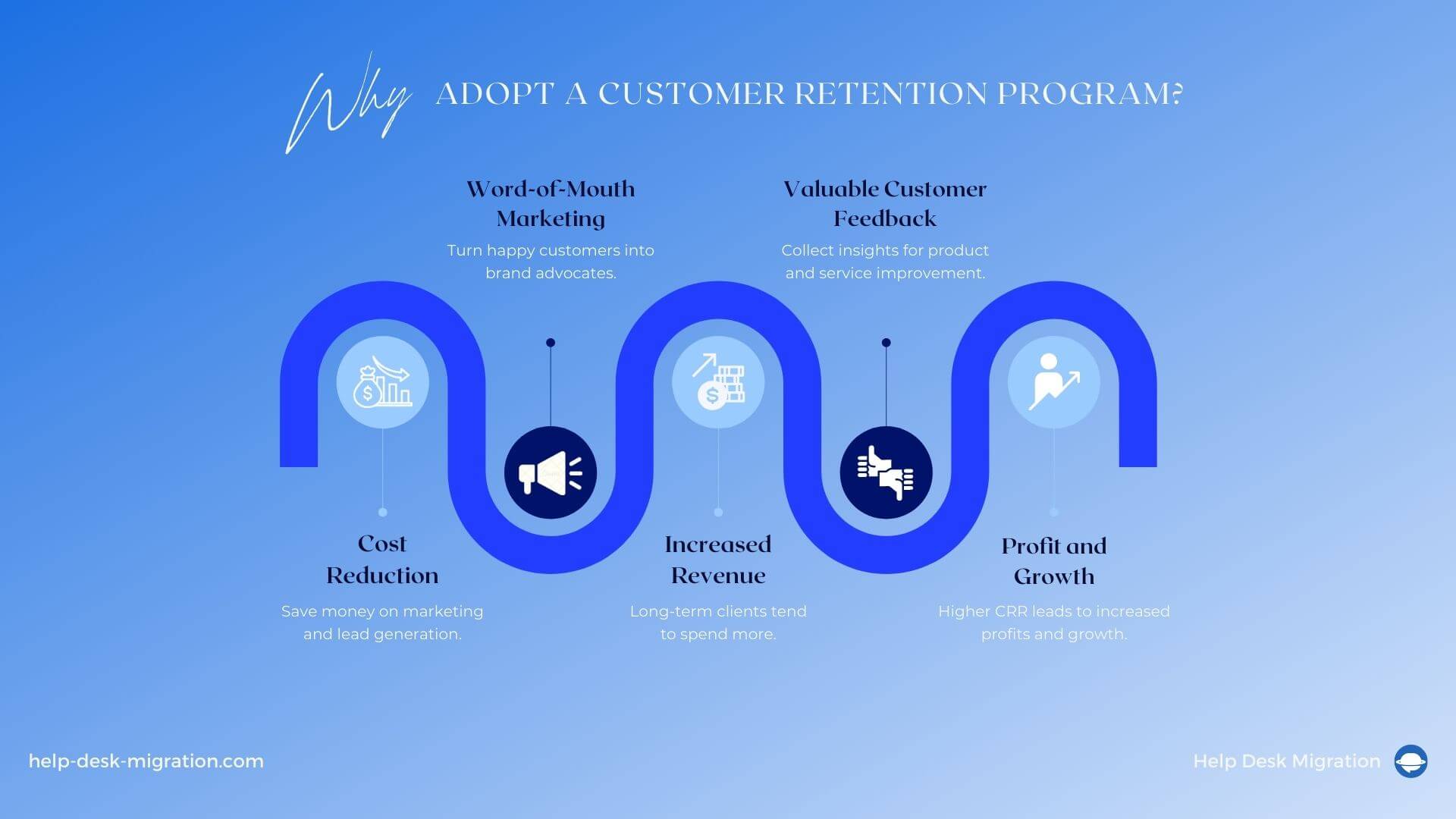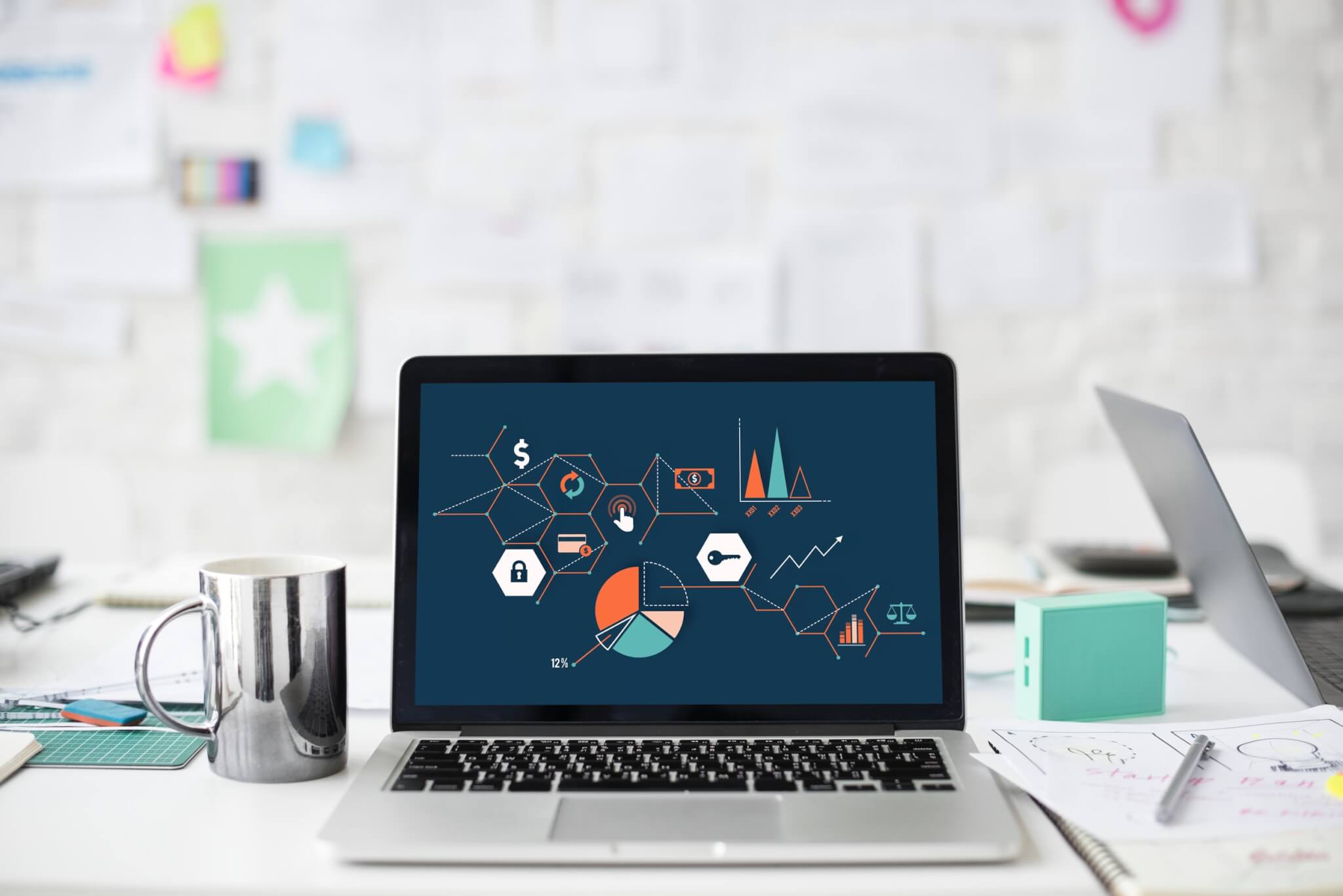Imagine a customer who not only returns to your store time and again but also brings along friends and family who also make purchases. A dream? No, it's a reality if you know how to use customer retention strategies wisely.
If you’re looking to cultivate customer loyalty, read on. We'll explore the art and significance of customer retention and unveil effective strategies that transform one-time buyers into repeat customers and steadfast advocates.
Let's start with the basics.
What Is Customer Retention?
A customer retention program, or customer retention strategy, is a company’s set of specific actions designed to encourage its customers to stick around. From a customer support point of view, this typically involves personalized support, efficient issue resolution, and proactive communication. Automated help desk workflows make it easy to achieve these objectives.
But why is a proper customer retention program so critical? Let's explore.
Why Is a Customer Retention Program Vital for Business?
Introducing a client retention strategy might seem complicated, costly, and unnecessary, especially when your customer acquisition effort works well. But retention of customers contributes to your business’ growth, allowing you to:

Spend less
Retaining existing customers is cheaper than attracting new buyers. Cost reduction occurs because you spend less on marketing, advertising, researching your customers, and nurturing new leads.
Let customers advocate for your brand
Happy customers become brand advocates and spread the news of their positive experiences with your company by word-of-mouth. They influence friends, colleagues, and acquaintances to trust your company, bringing you new customers for free.
Increase revenue
Retaining clients spend more over time and are less price-sensitive, contributing to higher revenue. Research shows that loyal customers are 23% more likely than the average customer to purchase from your company. Moreover, existing customers are more receptive to trying new products and premium offerings as they have more trust in the company.
Get better customer feedback
Long-term customers know your company and service better than others. They provide valuable feedback by reporting on their experiences over time, which helps improve products and services.
Basically, all these benefits show that a high customer retention rate (CRR) means higher profit and faster company growth.
And in case you need a refresher on the formulas to calculate CRR and related metrics, let’s review them.
How to Сalculate Effectiveness of Your Customer Retention
Measuring and analyzing various metrics is the best way to determine if your client retention strategies work effectively. And for this purpose, you need to know a few formulas.
| Metric | Definition | Formula |
| Customer Retention Rate (CRR) | % of retained customers during a time period | ((CE - CN) / CS) x 100 |
| Customer Churn Rate (CCR) | % of customers lost during a time period | (CC / CS) x 100 |
| Customer Lifetime Value (CLV) | Total revenue expected from a single customer | (Avg. Purchase Value) x (Avg. Purchase Freq.) x (Avg. Customer Lifespan) |
| Repeat Customer Rate (RCR) | % of customers making multiple purchases | (Repeat Customers / Total Customers) x 100 |
| Purchase Frequency (PF) | Frequency of customer purchases within a timeframe | Total Purchases / Number of Unique Customers |
Customer retention rate (CRR)
This metric shows how many customers you retained during a certain time period.
Where
- CE = Number of customers at the end of a time period
- CN = Number of new customers acquired during that time period
- CS = Number of customers at the start of that time period
Customer churn rate (CCR)
CCR is the opposite of CRR — it refers to the percentage of customers you've lost.
Where
- CC = Number of customers lost during a time period
- CS = Number of customers at the start of that time period
Customer lifetime value (CLV)
CLV is the total revenue a business can expect from a single customer throughout their entire relationship. You can calculate an average across all customers or calculate it per client.
Where
- Average purchase value = Total revenue / Number of purchases
- Average purchase frequency = Total purchases / Number of customers
- Average customer lifespan = Total time period / Number of customers
Repeat customer rate (RCR)
RCR measures the percentage of customers who make multiple purchases from a business over a specific period of time.
Purchase frequency (PF)
This metric shows how often customers make a purchase within a given timeframe.
Knowing these metrics, you can evaluate whether your strategies for customer retention are successful or if you need to improve specific metrics, such as purchase frequency. The following strategies can help you improve retention.
Proven Client Retention Strategies
Any action that improves customer experience and satisfaction can become part of your customer retention strategies. Here we listed a few of the most effective practices your marketing and customer support teams should adopt.

Provide omnichannel support
The more communication channels you have, the easier it is for your customers to reach you. Plus, if you have a system that connects all your channels, support agents see a complete history of the company’s interaction with customers and have all the data needed to personalize service.
Reply to customer support inquiries promptly
Fast response times are crucial for customer satisfaction. If five years ago, two-thirds of customers expected a response within ten minutes, you can’t provide anything less to today’s customers. Optimize your support network with ticket prioritization and automated response options like chatbots to cut response time to a minimum and meet customer expectations.
Personalize customer experience
Research shows that 69% of online customers want a personalized and consistent customer experience across multiple channels, but few organizations provide it. This means personalization may be a competitive advantage that can tremendously impact your retention rate.
You can personalize customer experiences by continually collecting data and providing support agents with customer service tools to access that data in a few clicks. This way, you can know everything about their past experiences without asking and recommend products that are likely to interest customers.
Show clients you know and care about their specific needs and see how that augments the retention of your customers.
Encourage loyalty
Customers love when you reward their loyalty with special treatment. Make them feel special by offering customized loyalty programs.
You can provide discounts, early-access benefits, limited-time offers, and other bonuses for spending certain sums or joining loyalty programs. You can encourage loyalty in many ways as long as you follow one rule — make conditions clear and achievable.
Offer a referral program
As you already know, loyal customers are your best advocates and marketers. But to encourage them to advertise your company, sometimes you need to entice them.
A referral program is the best way to do this, and it has a perfectly simple formula:
- Your current customer sends a link to a friend to register for news or a discount from your company.
- Your customer receives a small reward for their efforts, like bonuses or discounts.
As a result, your customer has another reason to stay with your brand, and you have new leads to work with.
Ask your customers
Nobody can tell you how to retain your customers and provide service better than your customers themselves. So ask them.
- Send a short questionnaire after addressing an inquiry to evaluate the quality of service
- Occasionally email extended questionnaires to ask what actions would encourage them to make more purchases
- Collect and analyze feedback from open sources like review sites
This way, you can define the most promising directions to focus your efforts for improving customer retention.
Educate your audience
To fully appreciate your product, customers need to know how to use it to its full capacity.
So, you'd better be there to educate them on a product functions and features, and to provide useful tips. Post helpful videos on social media, host online training and streaming events to keep customers updated, and send them how-to guides and pointers by email.
Build a customer community
Another way to increase customer retention rate and loyalty is to help customers feel like they’re part of something bigger by offering an online community.
An advantage of online communities is better customer support because sometimes other customers can provide help faster than support agents. Online communities are also an additional channel to gather feedback and learn more about your customers.
Support and encourage your employees
Your employees are key providers of quality service and facilitators of client retention. You must ensure a positive work environment that encourages employee longevity. That means don’t overload them with work, don’t make them work long shifts, and don’t make them meet extreme performance goals. Provide fair and supportive management.
Use automation
All of the above strategies for retaining customers can be achieved by adopting automated customer service tools. Automated tools can help avoid work overloads, reduce response times, manage loyalty programs, and personalize the customer experience by taking on mundane tasks like writing emails and collecting data.
And if you don’t have automated software because you’re daunted by the prospect of transferring all your existing customer data to a new platform, don’t worry — Help Desk Migration can assist you.
While you’re thinking about devising a customer retention strategy and how to bring it to life, let's look at some successful real-life examples for inspiration.
Five Real-Life Examples of Customer Retention Strategies
As we said, any strategy aimed at raising customer satisfaction and interest in your company can help you improve your customer retention rate. The following customer retention strategies examples from famous brands prove the point.
Hilton Honors club
Hilton offers a free Hiltons Honors membership to all its customers. Depending on their total number of stays, customers can access different benefits (some of which are not available for purchase), like room upgrades and executive lounge access.
As a result, in 2019, the occupancy percentage for Hilton Honors members exceeded 60%, showing significant growth in its retention rate.
Airbnb’s empathetic customer relationships
Airbnb's customer support team takes time to understand and connect with its customers on a personal level. Their support representatives often engage in friendly conversations with customers about their travel plans, make local recommendations, and even recount their own personal stories.
This approach and emphasis on brand building brought Airbnb their strongest guest retention in years.
Patagonia’s value-based strategy
Customers like to buy from companies that share their values. Patagonia embraced this by introducing the Worn Wear initiative that encouraged customers to buy used Patagonia items or trade in their old gear for store credit.
This not only let customers save on purchases, but more importantly, it emphasized the value the company places on being environmentally responsible, leading Patagonia customers to stay loyal to the company.
Zendesk's automation for personalization
Zendesk introduced an AI-powered bot that analyzes customer inquiries and automatically suggests relevant help articles or solutions. If the bot can't answer the question, it creates a ticket, and an agent responds. The ticket contains all the known information about the customer's complaint and history so that the agent can provide personalized service.
As a result of quick and quality service, Zendesk has higher customer satisfaction and retention rates.
Miinto's multilingual support
If you're running an international business, your customers would love to communicate with your support team without using Google Translate. Miinto's, a Scandinavian fashion marketplace, understands this and offers chat in four languages to support clients.
As a result, customer support deflected 40% of calls, and agents could carry on multiple conversations simultaneously to serve more customers.
As you see from these best customer retention strategies examples, the trick is understanding your customers' expectations and needs and introducing a strategy that addresses them. But it’s also crucial to balance retention with acquisition efforts. Pushing one button too hard at the wrong time can slow down growth as badly as not pushing any.
How to Define the Right Moment to Focus on Client Retention
Different stages of the customer journey can dictate when to shift focus from customer acquisition toward retention of customers.
When you first start a business, it's about getting new customers on board. Later, as you see more repeat and loyal customers, you should focus on keeping them satisfied. As things stabilize, you aim for a balance between taking care of existing customers and bringing in new buyers.
As a business matures, keeping your loyal customers becomes essential — they bring in new customers through word-of-mouth, becoming the backbone of your growth.
Conclusion
Customer retention is crucial for business prosperity, ensuring devoted brand supporters and continued growth. Success stories from various companies show that you can improve retention by tailoring diverse strategies to suit your specific audience's needs.
One of the easiest ways to achieve this is by adopting automated customer support software that streamlines tasks and provides the data you need to evaluate and adjust your strategies. Choose one now, and trust data transfer to Help Desk Migration.
Frequently Asked Questions
A company's customer retention rate is the percentage of customers or clients that continue to do business with the company over a specific period. It measures the company's ability to retain existing customers and is often expressed as a percentage.
The four stages of customer retention typically include:
- Awareness: This is where customers become aware of the brand and its offerings.
- Acquisition: The stage where customers make their first purchase or engage with the company's products or services.
- Retention: The company works to keep customers coming back and maintaining their loyalty.
- Advocacy: Loyal customers become advocates, promoting the brand to others.
Key factors for customer retention include:
- Quality of products/services: Consistently delivering high-quality offerings.
- Effective communication: Engaging with customers through various channels.
- Customer support: Providing excellent support and addressing issues promptly.
- Loyalty programs: Implementing programs that reward loyal customers.
- Personalization: Tailoring interactions and offerings to individual customer needs.
Customer retention can be categorized into different types:
- Contractual retention: Applicable in subscription-based services.
- Non-contractual retention: Applied to businesses with no formal contracts.
- Behavioral retention: Focusing on customer actions and behaviors.
- Customer loyalty: Building strong emotional connections with customers.
- Preventive retention: Identifying and addressing potential reasons for churn.
The customer retention stage is the phase in the customer lifecycle where a company aims to maintain and strengthen its relationship with existing customers. This involves strategies to encourage repeat purchases, increase customer loyalty, and reduce churn or attrition. The ultimate goal is to keep customers engaged, satisfied, and coming back for more business.


